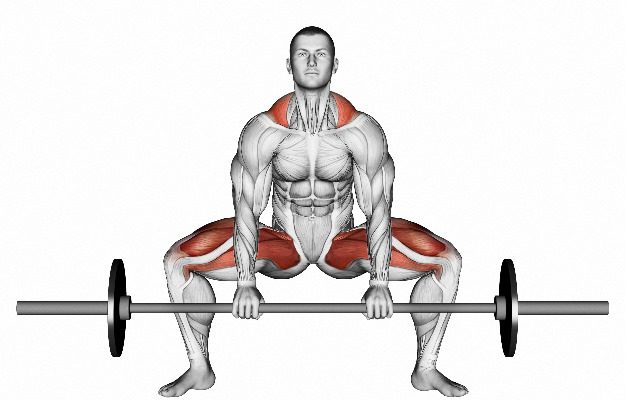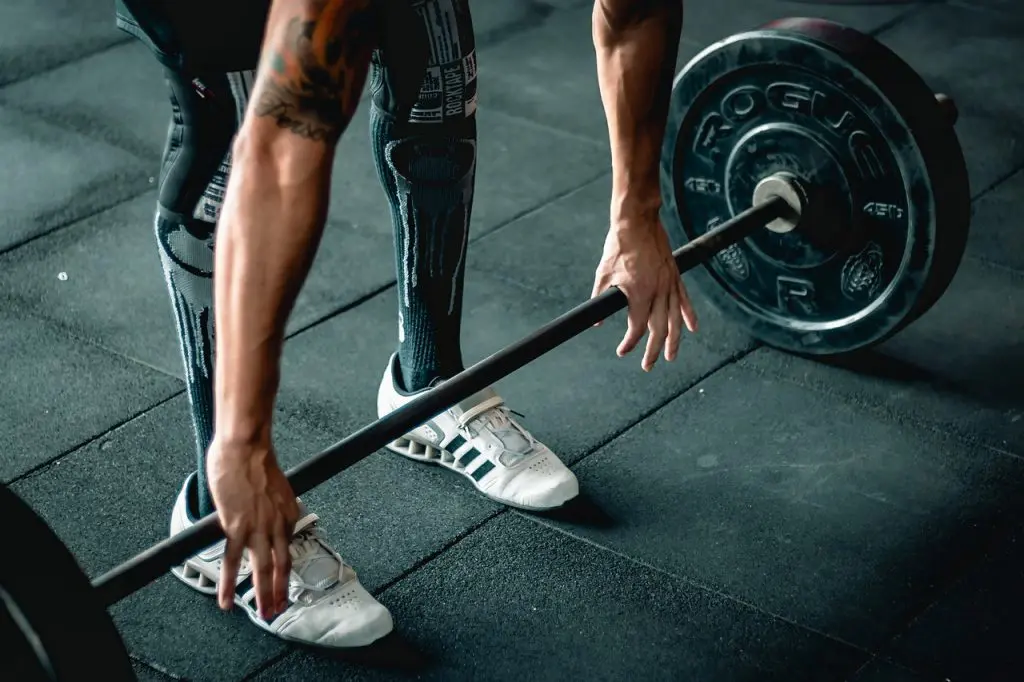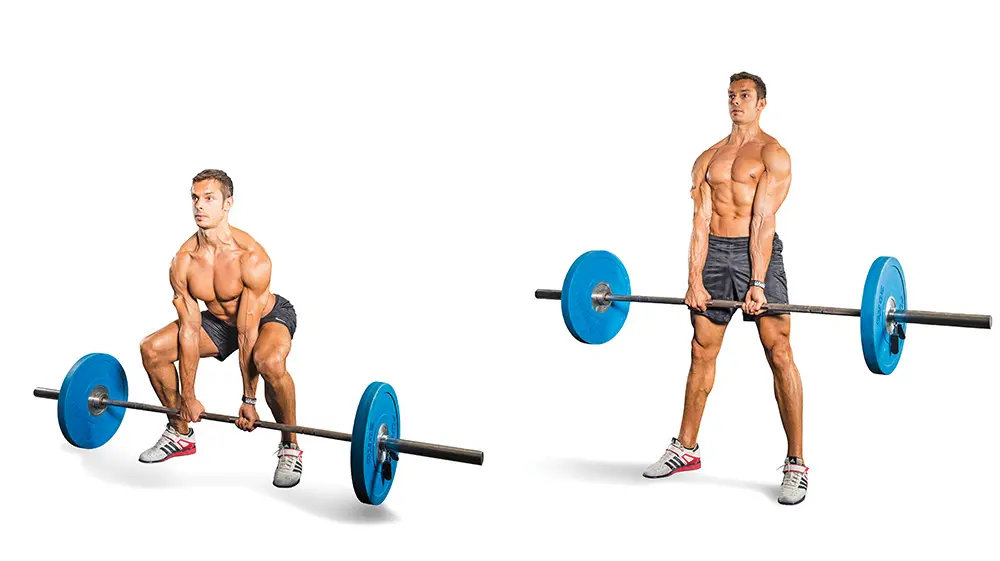
The best online fitness resource you'll ever need. We filter out the BS to ensure you meet your health and fitness goals!

The best online fitness resource you'll ever need. We filter out the BS to ensure you meet your health and fitness goals!

The barbell deadlift is one of the best resistance exercises going. It helps to develop overall strength, site-specific strength in the back and legs, as well as stability and musculature through the posterior chain.
It can be seen in powerlifting meets as one of the big three competitive lifts (alongside squats and bench press), and variations on deadlifts feature prominently in events for other disciplines, such as Strongman competitions and CrossFit Games.
Aside from its use in competition, the deadlift is generally considered something of a benchmark in training and testing overall strength, as well as being a go-to exercise for many looking to develop mass through their backs and lower bodies.
When the deadlift is performed with feet around hip width apart (sometimes slightly inside or outside, depending on the personal preference of the lifter involved), with hands outside the knees and the barbell lifting from the floor, we call it the ‘conventional deadlift’. When in doubt, this is what people talk about when they talk about deadlifting. This is what most powerlifting meets will see and it is often the default for new lifters as they begin to learn movements and figure out what works for them.
When the feet are wide, far outside of hip width and often angled with the toes pointing outwards, heels slightly in, with hands inside the knees, it is a ‘sumo deadlift’. This is a very common variation on the classic deadlift. Though it won’t be seen as often, either in competition or training, it still has a great many uses and, as we will see, is more than a match for the conventional lift.
But which one is better, and what do we mean by ‘better’? In this article, we will look at the benefits of deadlifting in general, how they relate to conventional and sumo deadlifting specifically, how each works as a test of strength, and indeed how comparable they both are, as we discuss which should come out on top.
Let’s begin by talking in general terms- similar benefits can be gained from both the conventional and sumo deadlifts. This, in itself, should give you a clue as to which wins between the two (hint: they are both amazing.)
Both types of deadlift (in fact, pretty much any deadlift variation) will primarily target the muscles of the posterior chain. These include the lower back, hamstrings and glutes. However, they will additionally work the lats and traps in the mid- and upper- back, as well as the forearms, all very directly. Finally, they will work the quads, biceps, shoulders and core as secondary muscle groups. They really do give you a full body workout.
Because of this, both the sumo and conventional deadlift build great core strength and stability, as well as eliciting a great deal of hypertrophy throughout the body. We’ll go into this in more detail shortly.
Though we are perhaps more used to seeing heavy deadlifts (and, indeed, this is where they usually excel), deadlift variations can be performed at any weight range with benefits to be gained. Moderate weights, at high reps, will elicit hypertrophy, though core engagement and power generation will fall.
Deadlifts are really easy to scale. If range of motion is an issue, the barbell can be raised up, either for a rack pull variation (both conventional or sumo stance), or for a deficit deadlift from blocks. If grip is an issue, straps can be worn (even the best deadlifters use straps in the higher ranges, as grip will give out way before your posterior chain has had enough!) Finally, strength will always be an issue- that’s why we all enter into strength training to begin with. As a barbell move, this is very easy to scale: most lifters start off with a bare bar, or perhaps 5-10kg on each side, before adding plates progressively as the weeks progress.
Finally, any deadlift variation has fantastic practical carry-over. Stooping down, taking hold of something heavy, and standing up again to lift it, is one of the most basic, primal moves are bodies are built to do. Whether this is handling heavy shopping bags or luggage, picking up your children, helping to move furniture, or any other daily, common occurrence, the posterior chain’s ability to move under load is vital to long-term health and functionality. Training it to be as strong as stable as possible is arguably far more important than being able to bench twice your bodyweight or run a marathon.

Let’s take a bit of a closer look at the muscles involved in deadlifting- either conventional or sumo.
As we have seen, deadlifts work your entire body. Your legs are the prime movers. Your back muscles keep your spine neutral and allow you to control the bar. You core keeps the tension going into the load, allowing you to perform the movement without leaking power. Your arms keep the bar in your hands, under your control.
Due to the intensity of the deadlift, and the scale of the weights often used, pretty much every muscle in the body comes under some form of tension, especially isometric tension.
The muscles typically engaged and worked during any variety of deadlift include:
No matter the style of deadlift you use, these muscles will all play their part. They will all work hard, and will all be challenged: growth and strength increases will be elicited in them all.

We’ll run through this section with particular reference to the conventional deadlift. Realistically, it’s where most people start out- and should do- and it is easy to alter conventional technique for sumo technique with just a few small changes.
The basics of how to perform either a conventional or sumo deadlift are simple:
Of course, there is a lot more to it than this, but this is a decent starting point and a good way to cue yourself as you set up for each lift.
With both conventional and sumo deadlifts, the weight needs to be ‘dead’- this is where we get the name deadlift from. This means you are lifting a dead weight, from inertia, from the ground. Therefore, every rep has to start from the floor and end with the bar setting down on the floor, with no bounce in-between.
Most of what we have already run through applies equally to the sumo deadlift as the conventional deadlift. However, the sumo deadlift will make use of a wider stance, a closer hand position, and usually a much straighter torso.
The wider stance shortens the lifter’s leg range of motion: this reduces the range of motion of the whole lift in comparison with a conventional deadlift. When lifters report being able to lift more using a sumo stance than conventional, this is often one of the main reasons: they are not having to move the bar as far as a conventional deadlift requires.
In addition, as the sumo deadlift puts the lifter’s torso more upright, less strength is needed in the back muscles, particularly the erector spinae. Instead, it relies a little more on the quadriceps and adductors and a little less on the posterior chain muscles. The quadriceps are some of the largest, most powerful muscles in the body (hopefully you have realised this whilst ascending from a particularly heavy squat rep or two!) This is another reason that many lifters can handle heavier weight in the sumo deadlift compared to conventional.
This is also why novices should often start out with conventional lifts. Conventional deadlifts work the body far more globally, putting pressure through the back and posterior chain, rather than relying so heavily on the legs. Conventional deadlifts are better at developing overall strength and power, though we will go into this in more detail below.
The sumo deadlift is named after sumo wrestlers- it mimics their wide legged, low stance. Sumo wrestlers adopt this stance as it is a mechanically very strong position- so too with the sumo deadlift.
This is the main difference in set-up between the sumo and conventional deadlift.
Rather than keeping the feet around hip-width, the feet are placed well outside of hip-width for the sumo deadlift. Though the amount varies between lifters, their preferences and body mechanics, some take a considerably wider stance than they would for squats, for example.
In addition, the feet will be turned further outwards in a sumo deadlift than they would for conventional- again, playing into that traditional sumo wrestler posture. Whilst a 10-15 degree angle is generally appropriate for a conventional deadlift, sumo deadlifts will be closer to 30-40 degrees.
Secondly, with the feet so wide apart, the hands will have to be inside the knees, around shoulder-width. The same grips (over-under, overhand or hook grip) can be used between the sumo and conventional deadlifts, and strap use will become inevitable at higher weight ranges.
Other than these changes- and the inevitable mechanical differences involved, set up and execution will be the same for both sumo and conventional deadlifts, with the same cues and same rules applying to each.

Because of the changed mechanics involved in adopting a sumo stance, the body mechanics throughout the entire movement are altered. Though it remains the same basic move as a conventional deadlift, as mentioned above, the stance changes in a sumo deadlift cause different muscles to take different ratios of the weight and deliver different ratios of power. It also changes a lifter’s centre of gravity slightly.
We have seen the differences in the torso angle and the muscles used during a sumo deadlift, and we’ll go into more detail shortly on the differences between the two movements. However, for execution, a lifter performing a sumo deadlift needs to bear a couple of things in mind.
Firstly, they will want to sit back a little bit more than they would for a conventional deadlift. This will keep their centre of gravity where it needs to be- close at hand and as directly under their body as possible.
Secondly, thighs will want to drop deeper in a sumo deadlift than they would for a conventional. A conventional should never see thighs even drawing parallel to the ground. A sumo stance may enable this, or it may even enable a lifter to go below parallel. If this feels right, and the loading still hits the posterior chain as much as possible, this is absolutely acceptable.
There are some common mistakes that lifters often make with the deadlift, both conventional and sumo. Some of them will reduce the deadlift’s efficacy, some the amount of weight a lifter can move, whilst some will make the movement outright dangerous. It is therefore wise to avoid them all.
Common pitfalls include:
All of these mistakes apply equally to the sumo and conventional deadlift, showing you just how similar they are, and how many of the same mechanisms cross over between the two. Regardless of which lift you choose to focus on, eliminating these errors will keep you stronger, safer, and will ultimately make you a better deadlifter across the board.
Both sumo and conventional deadlifts are hardcore exercises that will make you stronger, fitter and more muscular if you incorporate them into your lifting regime. This being said, there are some crucial differences between the two.
As mentioned above, sumo deadlifts allow you to bring your thighs closer to parallel with the ground (or even below parallel) because of their wider foot positioning and the more open hip angle they bring about. As you might have realised, this will look a lot more like a squat than a deadlift in this respect. This means that they demand more of the quadriceps than the conventional deadlift, making them perfect for building mass through the lower body whilst still getting some of the benefits of a deadlift.
The is also more stimulation to the trapezius muscles during a sumo deadlift than during a conventional one, due to the closer hand position. This means that you will build the mass around your neck and upper back more efficiently by performing them.
Your torso will also be more upright during a sumo deadlift. Whilst this isn’t a benefit in and of itself, it can make the sumo deadlift far more comfortable, especially for those with any kind of balance or orientation problems (such as vertigo or inner ear infections).
The inverse will be true for a conventional deadlift. With the higher hip and thigh position involved, the quadriceps won’t do so much of the work. The wider hand position will mean the lats take more of the pressure in the back, compared to the trapezius muscles. All in all, this means a greater workout for the muscles of the posterior chain: the hamstrings, glutes, lower back and erector spinae.
However, these are all matters of emphasis. A conventional deadlift will still work your quadriceps and traps. A sumo deadlift will still work your lower back, lats and hamstrings. Both will work your deep core muscles about as hard as any exercise can; both will lead to greater overall mass and strength throughout your entire body.
Realistically, unless you have a pressing need to perform one over another- or if you particularly need to work some of the muscle groups mentioned above- both sumo and conventional deadlifts are actually pretty interchangeable in terms of training effect and effort involved.
Performed correctly, both are incredibly safe. Performed incorrectly, with some of the errors mentioned above taking place, both are pretty dangerous.
However, the sumo deadlift is perhaps slightly safer, especially for the lower back. The upright torso starting position makes correct spinal alignment a lot easier. However, as both load the back in pretty much the same intensity, and as both rely on good core strength and stability, this isn’t actually that much of a difference.
Rather than focussing on which is safer, focus on getting the basics right. The common pitfalls mentioned above should be avoided: this will keep you safe in whatever variation you choose. The basic set-up should be mastered: again, this will keep you safe, strong and efficient in any deadlift technique.

The short answer is: try them both, see which you prefer and go with that.
Or, alternatively: include them both, using sumo deadlifts as a strong alternative when you want to, or as a great accessory at lighter loads on leg days.
Either will suffice. Both will serve you very well.
The main factors that will determine which is best for you, however, bare taking into consideration. Mainly, this is anatomical. It will largely come down to your leg length and your femur’s attachment to the hip: long legs, and particularly femurs, will often find conventional deadlifts quite challenging. Therefore, many taller people will favour the sumo deadlift, whilst shorter athletes will typically get more out of the conventional.
In addition, hamstring flexibility is a factor. Those with naturally shorter hamstring insertions (tight hamstrings) will also find a conventional challenging. Sumo deadlifts will often be more appropriate to them.
Your aims are also important in determining which to go with. If both are easy and accessible to you, choose your deadlift based on what you need to work on.
If you’re a powerlifter coming up to a meet, you will want to honour specificity and go with the conventional. Additionally, if you want to work posterior chain strength and mid-back size, go with conventional.
However, if you’re at a phase in your training in which you need to focus on legs and/or shoulders, the sumo deadlift is a perfect complement to both.
The takeaway from this
The deadlift is amongst the best exercises (if not the best) for building full body strength and muscularity. Regularly including heavy and medium weight deadlifts of any style will give you a denser, more solid deep core sections, a broader, deeper, stronger back, and a more athletic bearing.
Variation can be fun, and one deadlift may suit you over another, but the main thing you need to know is that, whatever form it takes, you should be deadlifting. Doing the same style over and over again is perfectly fine (as long as you honour the principle of overload).
Go for whichever is most comfortable, most natural, and most befitting your goals. Neither is inherently better or worse than the other: they are simply fit for slightly (slightly!) different purposes.